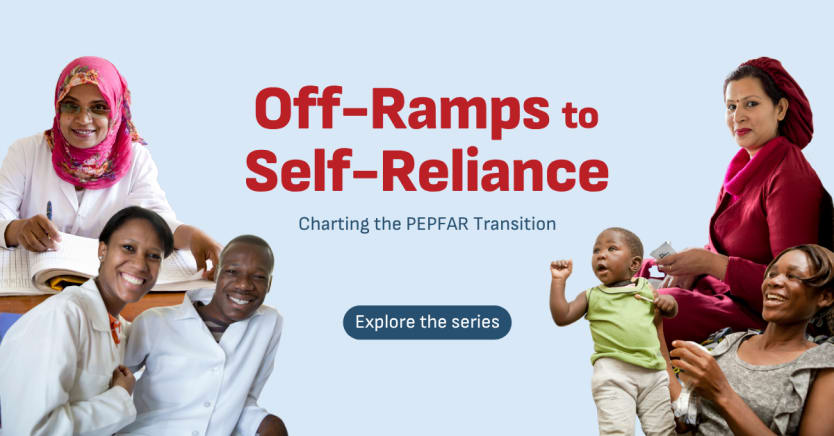
For two decades, the U.S. President's Emergency Plan for AIDS Relief, or PEPFAR, has saved lives at historic scale. The question now is how to shift the center of gravity to national ownership without losing the gains.
As we’ve learned through our implementation of PEPFAR’s Efficiencies for Clinical HIV Outcomes, or ECHO, program, Mozambique offers a cost-effective, practical answer: Transition by design, not by drawdown.
This “smarter transition” is possible when donors get behind, not ahead of, domestic systems and priorities, and when investments are intentionally organized around three principles: better use of existing digital health systems, stronger government capacity and accountability, and community-based service delivery that keeps people on treatment.
Build on the data backbone you already have
“Integrated digital systems” can sound like jargon. In Mozambique, it means improving how the Ministry of Health uses platforms already in place — such as electronic patient tracking systems, or EPTS, and national DHIS2-based tools — so program managers can see what’s happening and act on it.
Progress is tangible here. Lab and pharmacy flows are being automated. Provincial dashboards are going live. Patient-level tracking is becoming reliable enough to guide outreach. But here’s the challenge: Too many systems still exist mainly to satisfy donor reporting, not to serve the country’s own decision-making.
The real opportunity is to expand EPTS so it functions as the government’s health management information system, feeding into national systems while simplifying data entry. Going fully digital at the facility level is the dream, but it comes with real-world hurdles: energy shortages, security risks, and daily operational constraints.
Partners have stepped up with connectivity, devices, and secure cloud services. The goal is not to create parallel systems, but to make national ones faster, interoperable, and decision-ready. That’s how data becomes an accountability tool for a country-led HIV response.
Government-led, partner-supported
Our experience in Mozambique shows progress on all three pillars of sustainability: technical, the health system’s ability to independently manage and improve services and set up strategic interventions; political, when leaders and communities own the agenda; and financial, domestic budgets that shoulder a growing share over time.
Day-to-day, that looks like provincial health authorities using routine data to target support, standard budgets that roll HIV line items into annual planning, and cost-effectiveness guiding choices at the margin.
Program budgeting and marginal analysis — simple, transparent “which activity buys us the most health now?” thinking — helps align PEPFAR and domestic funds with what works and is affordable to maintain. It means fewer donor-only functions and more ministry-led decisions, with partners providing catalytic expertise where it adds value.

Keep services where the epidemic lives: Communities
Facility-only approaches miss too many people. Long distances, transport costs, stigma, and workforce shortages are not solved by clinic guidelines alone. Mozambique’s transition keeps a strong community backbone: lay testing and counseling, linkages from diagnosis to treatment, defaulter tracing, adherence support, targeted help for patients with unsuppressed viral load, and community-based antiretroviral therapy, or ART, delivery by health providers.
These are not nice to haves; they are the glue that protects viral suppression and prevents resistance and mother-to-child transmission. Starving community systems to save money will fail. Loss to follow-up and treatment interruptions will ultimately cost more money and lives.
Integrate HIV into primary health care and budgets
Sustainability is easier when HIV isn’t treated as a silo. Integration into primary health care spreads fixed costs, strengthens political backing, and makes it more natural to defend HIV funding inside domestic budgets.
Training clinicians through e-learning and mentorship to deliver HIV services alongside maternal, tuberculosis, and noncommunicable disease care builds institutional memory and reduces dependence on external technical assistance. Integrated digital and supply-chain workflows mean one set of tools, one set of supervisors, and fewer duplicative visits. They lead to HIV services that are ubiquitous, routine, and owned — not special projects that switch off when a grant ends.
What PEPFAR should do next: The Mozambique model, distilled
1. Codify a transition compact at provincial level. Agree on a three-year plan where the country’s ministry of health leads priority-setting and partner support is time-bound and function-specific — for example, analytics coaching, last-mile connectivity, and targeted human resources for health backfill. Include clear performance metrics, quarterly reviews, and a glidepath for shifting specific costs to domestic budgets.
2. Fund the “boring but decisive” data work. Invest in interoperability, routine data quality improvement, and simple dashboards that provincial directors actually use to ensure district- and facility-level data collection. Focus on patient-level continuity — who started, who stayed, who needs a visit today — automated viral-load result flows, and pharmacy stock visibility to prevent avoidable interruptions.
3. Protect and professionalize community delivery. Support the government’s move to formalize community health workers and enable practical task-sharing to the lowest safe cadre. Tie partner grants to retention and re-suppression outcomes, not activity counts, and scale community services such as self-testing, where it reduces costs and improves continuity.
4. Make financing more predictable and efficient. Pilot cofinancing for a defined package — for example, community retention services and viral load logistics, with domestic funds covering an increasing share each year. Use cost-effectiveness thresholds to prioritize what to keep as donor support recedes, and earmark HIV budget lines inside provincial plans so they don’t evaporate under pressure.
5. Plan for shock resilience. Build contingency playbooks — from stockout dashboards to rapid community reengagement protocols — so service continuity survives political or economic shocks. The measure of a country-led program isn’t smooth sailing; it’s whether the system can self-correct when seas get rough.
If you’re shaping PEPFAR country plans, look to Mozambique for lessons: Lock a provincial transition compact, finance the data plumbing, and keep community delivery nonnegotiable. That is how we protect and build upon today’s gains.
This content is sponsored by Abt Global as part of Off-Ramps to Self-Reliance, a series exploring insights on the future of HIV programming and the multisectoral solutions that support countries’ off-ramps, resilient health systems, and sustained HIV progress. Click here to learn more.







